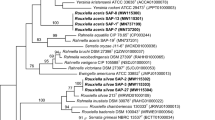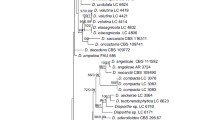Abstract
Thirteen isolates of Inonotus rickii/Ptychogaster cubensis, from different geographic provenances, were analyzed by sequencing ITS1, ITS 2 and 5,8S ribosomal RNA region. A phylogenetic tree, also including sequences available in Genbank database, showed that the strains enclosed in this study fall into two well-separated groups, one formed by isolates from Florida (USA) and the other one by isolates from Europe, Argentina and China. Differences were also highlighted on the growth rate of mycelial cultures at different temperatures. In fact, although the tested isolates generally attained the best growth at 30°C, isolates from Europe seem well adapted to higher temperatures and went on growing at 40°C whilst the growth of isolates from Florida significantly decreased at 35°C. Since the teleomorph I. rickii was never detected in Florida, and in this study noticeable differences were detected by analysis of ITS region, the existence of two possible distinct species, not discriminated solely on the basis of morphological characters, could be suggested.




Similar content being viewed by others
References
Annesi T, Coppola R, Motta E (2003) Decay and canker caused by Inonotus rickii spreading on more urban tree species. For Pathol 33:405–412
Annesi T, D’Amico L, Mazza G, Motta E, De Simone D (2010) Current status of Inonotus rickii in Mediterranean area. Petria 20:135–136
Barnard EL (1993) Inonotus rickii (anamorph: Ptychogaster cubensis): a wood-decaying fungus of importance to Florida hardwoods. Plant Pathology Circular No. 357 Florida DACS, Division of Plant Industry
Cenis JL (1992) Rapid extraction of fungal DNA for PCR amplification. Nucl Acid Res 20:2380
Dai YC, D’Amico L, Motta E, Annesi T (2010) First Report of Inonotus rickii causing canker and decay on Hevea brasiliensis in China. Plant Pathol 59:806 [Online: http://www.ndrs.org.uk/ BSPP NDR 20: 22]
Davidson RW, Campbell WA, Weber GF (1942) Ptychogaster cubensis, a wood-decaying fungus of southern oaks and waxmyrtle. Mycologia 34:142–153
Eck RV, Dayhoff MO (1966) Atlas of Protein Sequence and Structure. National Biomedical Research Foundation, Silver Springs, Maryland
Fischer M (2002) A new wood-decaying basidiomycete species associated with esca of gravepine: Fomitiporia mediterranea (Hymenochaetales). Mycol Progr 1:315–324
Gottlieb A, Wright JE, Moncalvo JM (2002) Inonotus s.l. in Argentina - morphology, cultural characters and molecular analyses. Mycol Progr 1:299–313
Intini M (1988) Contributo alla conoscenza dei funghi lignicoli italiani: Inonotus rickii (Pat.) Reid. Micol Ital 20:49–53
Intini M (2002) First report of Inonotus rickii Causing Canker Rot on Boxelder in Europe. Plant Dis 86:922
Kumar S, Dudley J, Nei M, Tamura K (2008) MEGA: a biologist-centric software for evolutionary analysis of DNA and protein sequences. Brief Bioinform 9:299–306
Mazza G, Moriondo M, Motta E, Annesi T (2008). Monitoraggio fitopatologico di Inonotus rickii nella città di Roma e applicazioni GPS-GIS. Forest@ 5:160-170 [Online: http://www.sisef.it/forest@/]
Melo I, Ramos P, Caetano MFF (2002) First record of Inonotus rickii (basidiomycetes, hymenochaetaceae) in Portugal. Port Acta Biol 20:265–269
Nei M, Kumar S (2000) Molecular Evolution and Phylogenetics. Oxford University Press, New York
Pegler DN (1964) A survey of the genus Inonotus (Polyporacecae). Trans Br Mycol Soc 47:175–195
Ramos P, Caetano MFF, Melo I (2008) Inonotus rickii (Pat) Reid. An important lignicolous Basidiomycete in urban trees. Rev Ciênc Agrárias 31:159–167
Ryvarden L (2004) Neotropical polypores. Part 1. Synopsis Fungorum 19. Fungiflora, Oslo, pp 1–229
Sneath PHA, Sokal RR (1973) Numerical Taxonomy. Freeman, San Francisco
Stalpers JA (1978) Identification of wood-inhabiting Aphyllophorales in pure culture. Stud Mycol 16:1–248
Stalpers JA (2000) The genus Ptychogaster. Karstenia 40:167–180
Tamura K, Nei M, Kumar S (2004) Prospects for inferring very large phylogenies by using the neighbor-joining method. Proc Natl Acad Sci USA 101:11030–11035
Tamura K, Dudley J, Masatoshi N, Kumar S (2007) MEGA4: Molecular Evolutionary Genetics Analysis (MEGA) Software Version 4.0. Mol Biol Evol 24:1596–1599
Tura D, Zmitrovich IV, Wasser SP, Nevo E (2009) Medicinal Species from Genera Inonotus and Phellinus (Aphyllophoromycetideae): cultural-morphological peculiarities, growth characteristics, and qualitative enzymatic activity tests. Int J Med Mushrooms 11:309–328
White TJ, Bruns T, Lee S, Taylor J (1990) Amplification and direct sequencing of fungal ribosomal RNA genes for phylogenetics. In: Innis MA, Gelfand DH, Sninsky JJ, White TJ (eds) PCR protocols: a guide to methods and applications. Academic, San Diego, USA, pp 315–322
Acknowledgements
This study was supported financially by the Italian Ministry of Agriculture, Food and Forestry. We wish to thank Edward. L. Barnard and Esperanza Sánchez Hernández for giving us fungal material from Levy County (FL, USA) and Cordoba (Spain) respectively.
Author information
Authors and Affiliations
Corresponding author
Rights and permissions
About this article
Cite this article
De Simone, D., D’Amico, L., Bressanin, D. et al. Molecular characterization of Inonotus rickii /Ptychogaster cubensis isolates from different geographic provenances. Mycol Progress 10, 301–306 (2011). https://doi.org/10.1007/s11557-010-0702-5
Received:
Accepted:
Published:
Issue Date:
DOI: https://doi.org/10.1007/s11557-010-0702-5




